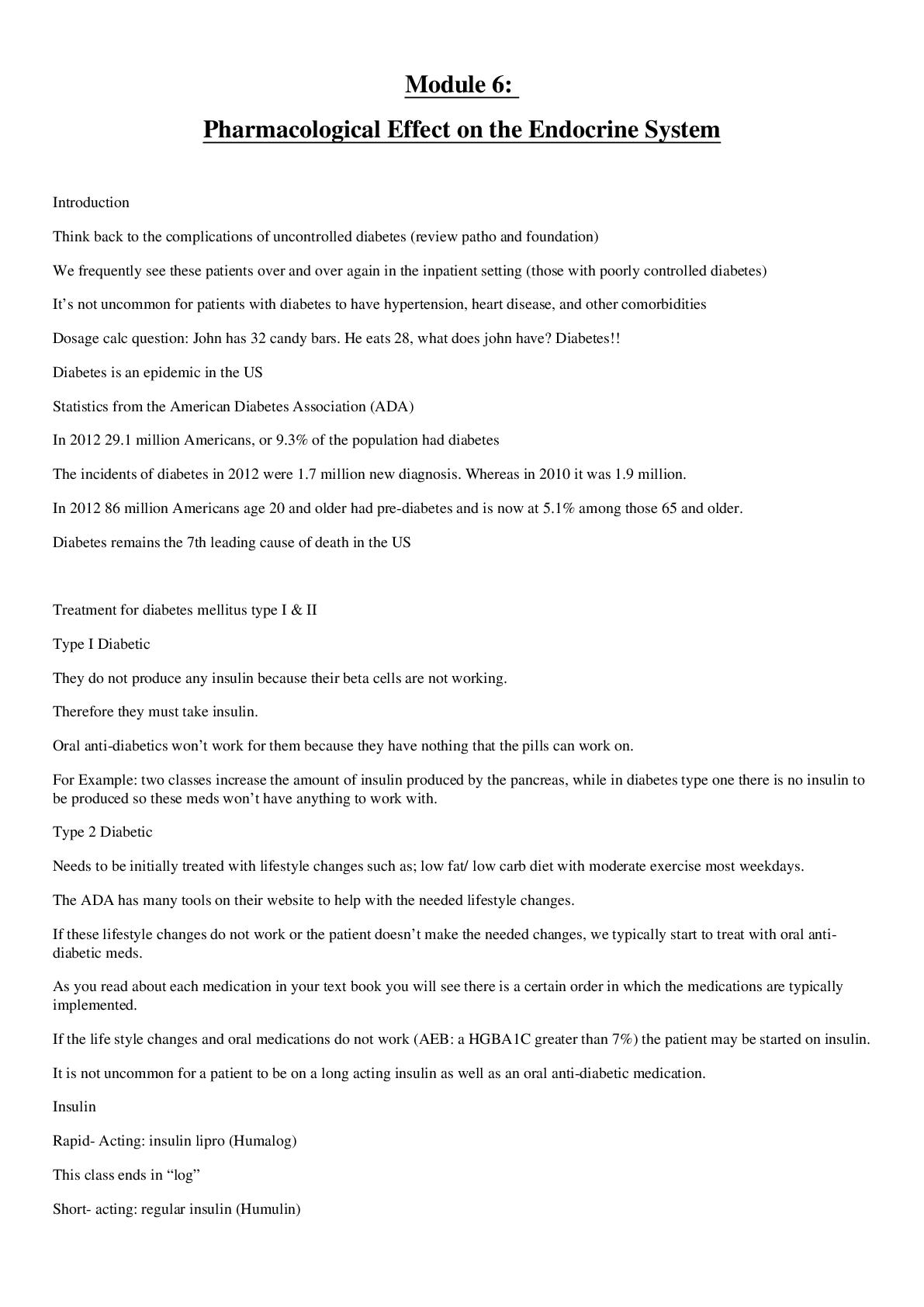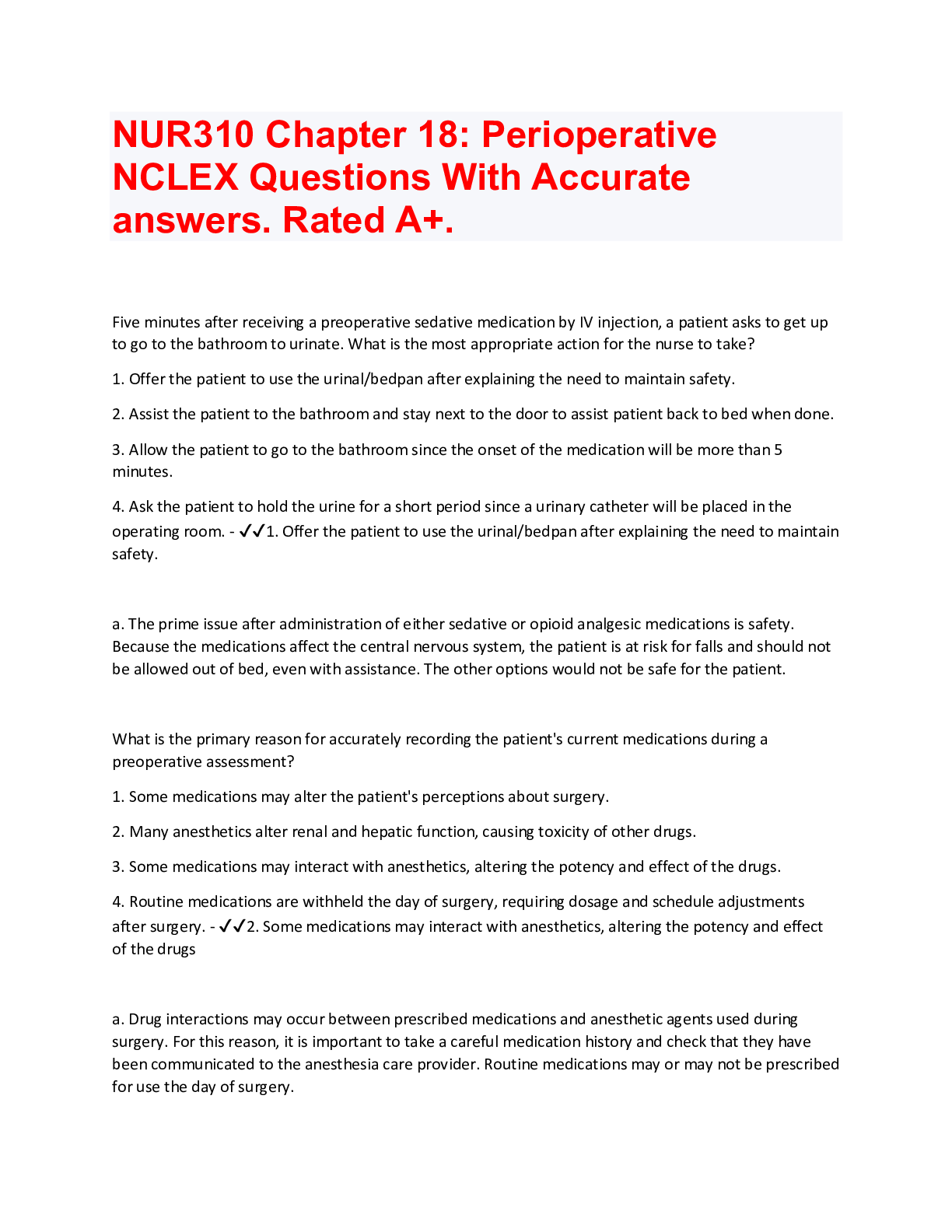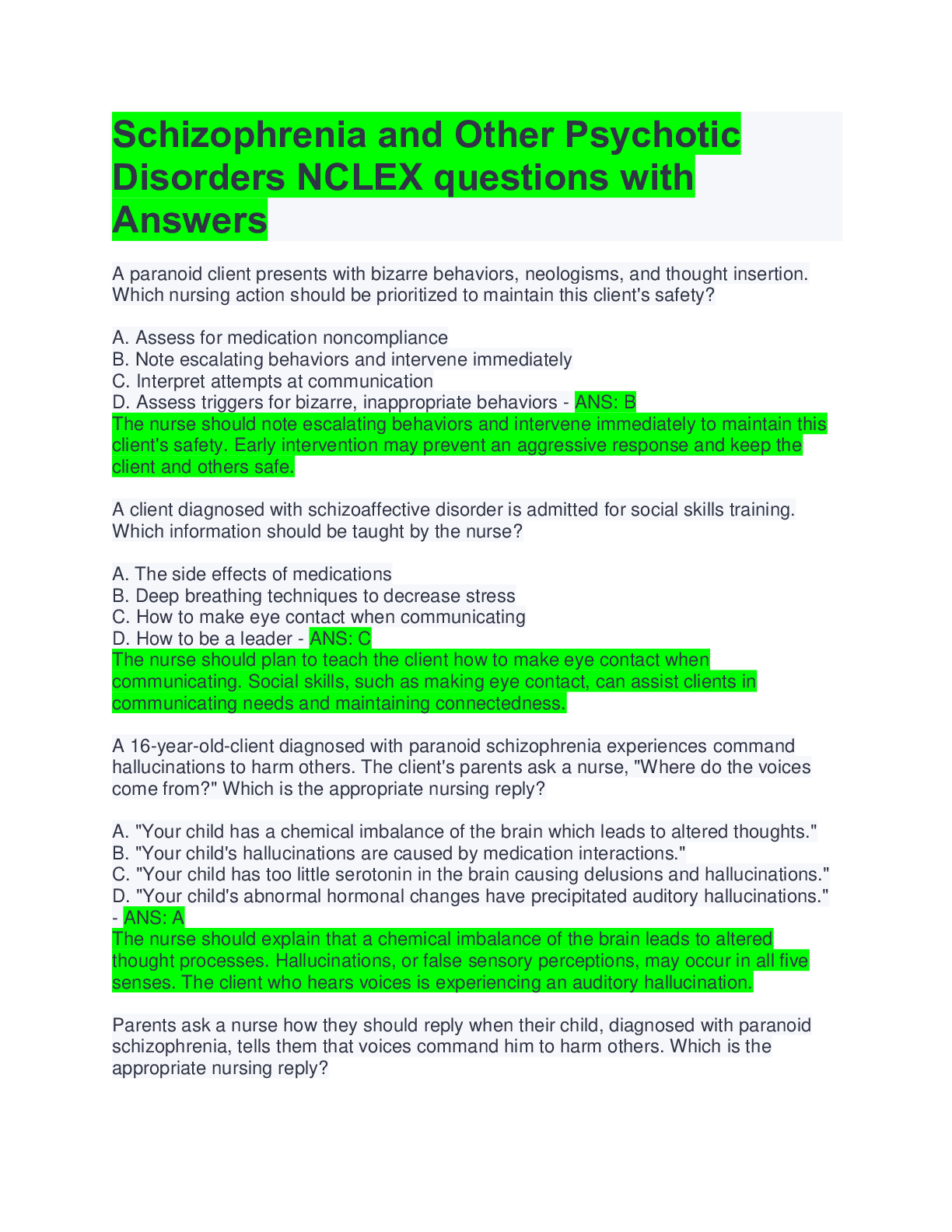*NURSING > QUESTIONS & ANSWERS > NUR 2474 Pharm Exam 2 NCLEX Questions with accurate answers. 2021/2022. Rated A+ (All)
NUR 2474 Pharm Exam 2 NCLEX Questions with accurate answers. 2021/2022. Rated A+
Document Content and Description Below
A patient is brought to the emergency department with shortness of breath, a respiratory rate of 30 breaths per minute, intercostal retractions, and frothy, pink sputum. The nurse caring for this pati... ent will expect to administer which drug? a.Furosemide (Lasix) b.Hydrochlorothiazide (HydroDIURIL) c.Mannitol (Osmitrol) d.Spironolactone (Aldactone) - ✔✔a.Furosemide (Lasix) Furosemide, a potent diuretic, is used when rapid or massive mobilization of fluids is needed. This patient shows severe signs of congestive heart failure with respiratory distress and pulmonary edema and needs immediate mobilization of fluid. Hydrochlorothiazide and spironolactone are not indicated for pulmonary edema, because their diuretic effects are less rapid. Mannitol is indicated for patients with increased intracranial pressure and must be discontinued immediately if signs of pulmonary congestion or heart failure occur. A patient who is taking digoxin is admitted to the hospital for treatment of congestive heart failure. The prescriber has ordered furosemide (Lasix). The nurse notes an irregular heart rate of 86 beats per minute, a respiratory rate of 22 breaths per minute, and a blood pressure of 130/82 mm Hg. The nurse auscultates crackles in both lungs. Which laboratory value causes the nurse the most concern? a.Blood glucose level of 120 mg/dL b.Oxygen saturation of 90% c.Potassium level of 3.5 mEq/L d.Sodium level of 140 mEq/L - ✔✔c.Potassium level of 3.5 mEq/L This patient has an irregular, rapid heartbeat that might be caused by a dysrhythmia. This patient's serum potassium level is low, which can trigger fatal dysrhythmias, especially in patients taking digoxin. Furosemide contributes to loss of potassium through its effects on the distal nephron. Potassium-sparing diuretics often are used in conjunction with furosemide to prevent this complication. This patient's serum glucose and sodium levels are normal and of no concern at this point, although they can be affected by furosemide. The oxygen saturation is somewhat low and needs to be monitored, although it may improve with diuresis. A patient has 2+ pitting edema of the lower extremities bilaterally. Auscultation of the lungs reveals crackles bilaterally, and the serum potassium level is 6 mEq/L. Which diuretic agent ordered by the prescriber should the nurse question? a.Bumetanide (Bumex) b.Furosemide (Lasix) c.Spironolactone (Aldactone) d.Hydrochlorothiazide (HydroDIURIL) - ✔✔c.Spironolactone (Aldactone) Spironolactone is a non-potassium-wasting diuretic; therefore, if the patient has a serum potassium level of 6 mEq/L, indicating hyperkalemia, an order for this drug should be questioned. Bumetanide, furosemide, and hydrochlorothiazide are potassium-wasting diuretics and would be appropriate to administer in a patient with hyperkalemia. A nurse preparing to administer morning medications notes that a patient with a history of hypertension has been prescribed the angiotensin-converting enzyme (ACE) inhibitor captopril (Capoten) concurrently with spironolactone (Aldactone). Morning laboratory results reveal a serum sodium level of 144 mg/dL, a serum potassium level of 5.1 mEq/L, and a blood glucose level of 128 mg/dL. Which intervention is appropriate? a.Administer the medications as ordered. b.Ask the patient about the use of salt substitutes. c.Contact the provider to report the laboratory values. d.Request an order for furosemide (Lasix). - ✔✔c.Contact the provider to report the laboratory values. Spironolactone should not be administered with ACE inhibitors, which can also elevate potassium levels. Because the potassium level is elevated, the nurse should not administer the medication and should obtain clarification of the order. There is no need to repeat the potassium level test that was just done this morning. Requesting an order for furosemide is appropriate only after the provider has been notified of the laboratory values. A patient with hypertension is taking furosemide (Lasix) for congestive heart failure. The prescriber orders digoxin to help increase cardiac output. What other medication will the nurse expect to be ordered for this patient? a.Bumetanide (Bumex) b.Chlorothiazide (Diuril) c.Hydrochlorothiazide (HydroDIURIL) d.Spironolactone (Aldactone) - ✔✔d.Spironolactone (Aldactone) Spironolactone is used in conjunction with furosemide because of its potassium-sparing effects. Furosemide can contribute to hypokalemia, which can increase the risk of fatal dysrhythmias, especially with digoxin administration. The other diuretics listed are all potassium-wasting diuretics. A patient is taking gentamicin (Garamycin) and furosemide (Lasix). The nurse should counsel this patient to report which symptom? a.Frequent nocturia b.Headaches c.Ringing in the ears d.Urinary retention - ✔✔c.Ringing in the ears Patients taking furosemide should be advised that the risk of furosemide-induced hearing loss can be increased when other ototoxic drugs, such as gentamicin, are also taken. Patients should be told to report tinnitus or dizziness or hearing loss. Nocturia may be an expected effect of furosemide. Headaches are not likely to occur with concomitant use of gentamicin and furosemide. Urinary retention is not an expected side effect. An older adult patient with congestive heart failure develops crackles in both lungs and pitting edema of all extremities. The physician orders hydrochlorothiazide (HydroDIURIL). Before administering this medication, the nurse reviews the patient's chart. Which laboratory value causes the nurse the most concern? a.Elevated creatinine clearance b.Elevated serum potassium level c.Normal blood glucose level d.Low levels of low-density lipoprotein (LDL) cholesterol - ✔✔a.Elevated creatinine clearance Hydrochlorothiazide should not be given to patients with severe renal impairment; therefore, an elevated creatinine clearance would cause the most concern. Thiazide diuretics are potassium-wasting drugs and thus may actually improve the patient's potassium level. Thiazides may elevate the serum glucose level in diabetic patients. Thiazides increase LDL cholesterol; however, this patient's levels are low, so this is not a risk. A patient with chronic congestive heart failure has repeated hospitalizations in spite of ongoing treatment with hydrochlorothiazide (HydroDIURIL) and digoxin. The prescriber has ordered spironolactone (Aldactone) to be added to this patient's drug regimen, and the nurse provides education about this medication. Which statement by the patient indicates understanding of the teaching? a."I can expect improvement within a few hours after taking this drug." b."I need to stop taking potassium supplements." c."I should use salt substitutes to prevent toxic side effects." d."I should watch closely for dehydration." - ✔✔b."I need to stop taking potassium supplements." Spironolactone is a potassium-sparing diuretic used to counter the potassium-wasting effects of hydrochlorothiazides. Patients taking potassium supplements are at risk for hyperkalemia when taking this medication, so they should be advised to stop the supplements. Spironolactone takes up to 48 hours to have effects. Salt substitutes contain high levels of potassium and are contraindicated. Spironolactone is a weak diuretic, so the risk of dehydration is not increased. A patient with hypertension is prescribed an angiotensin-converting enzyme (ACE) inhibitor. The nurse reviewing this patient's chart before administering the medication will be most concerned about which other disease process? a.Bronchial asthma b.Coronary artery disease c.Diabetes mellitus d.Renal artery stenosis - ✔✔d.Renal artery stenosis ACE inhibitors can cause severe renal insufficiency in patients with bilateral renal artery stenosis or stenosis in the artery to a single remaining kidney. Bronchial asthma, coronary artery disease, and diabetes mellitus are not comorbidities that are contraindications to treatment with an ACE inhibitor. A nurse administers an ACE inhibitor to a patient who is taking the drug for the first time. What will the nurse do? a.Instruct the patient not to get up without assistance. b.Make sure the patient takes a potassium supplement. c.Report the presence of a dry cough to the prescriber. d.Request an order for a diuretic to counter the side effects of the ACE inhibitor. - ✔✔a.Instruct the patient not to get up without assistance. Severe hypotension can result with the first dose of an ACE inhibitor. The patient should be discouraged from getting up without assistance. Potassium supplements are contraindicated. A dry cough is an expected side effect that eventually may cause a patient to discontinue the drug; however, it is not a contraindication to treatment. Diuretics can exacerbate hypotension and should be discontinued temporarily when a patient starts an ACE inhibitor. A patient who has been taking an antihypertensive medication for several years is recovering from a myocardial infarction. The prescriber changes the patient's medication to an ACE inhibitor. The patient asks the nurse why a new drug is necessary. What is the nurse's response? a."ACE inhibitors can prevent or reverse pathologic changes in the heart's structure." b."ACE inhibitors help lower LDL cholesterol and raise HDL cholesterol." c."ACE inhibitors increase venous return to the heart, improving cardiac output." d."ACE inhibitors regulate electrolytes that affect the cardiac rhythm." - ✔✔a."ACE inhibitors can prevent or reverse pathologic changes in the heart's structure." ACE inhibitors have many advantages over other antihypertensive medications, the most important of which is their ability to prevent or reverse pathologic changes in the heart and reduce the risk of cardiac mortality caused by hypertension. They are useful in patients with high low-density lipoprotein (LDL) or low high-density lipoprotein (HDL) cholesterol, but they do not directly affect this comorbidity. They reduce venous return to the heart, thereby reducing right heart size. They do not alter serum electrolyte levels A prescriber orders ramipril (Altace) for an obese patient with type 2 diabetes mellitus who has developed hypertension. The nurse provides teaching before dismissing the patient home. Which statement by the patient indicates understanding of the teaching? a."I am less likely to develop diabetic nephropathy when taking this medication." b."I should check my blood sugar more often, because hyperglycemia is a side effect of this drug." c."Taking this medication helps reduce my risk of stroke and heart attack." d."This medication will probably prevent the development of diabetic retinopathy." - ✔✔c."Taking this medication helps reduce my risk of stroke and heart attack." Ramipril (Altace) is approved for reducing the risk of stroke and myocardial infarction (MI) in patients at high risk for a major cardiovascular event because they have hypertension in conjunction with a history of stroke or MI or because they have diabetes. ACE inhibitors cannot be used for primary prevention of diabetic nephropathy, but they can delay the onset of overt nephropathy in patients who already have less advanced nephropathy. ACE inhibitors do not affect serum electrolytes or glucose. One ACE inhibitor, enalapril, can reduce the risk of diabetic retinopathy in some patients with type 1 diabetes mellitus. A patient begins taking an ACE inhibitor and complains of a dry cough. What does the nurse correctly tell the patient about this symptom? a.It indicates that a serious side effect has occurred. b.It is a common side effect that occurs in almost all patients taking the drug. c.It may be uncomfortable enough that the drug will need to be discontinued. d.It occurs frequently in patients taking the drug but will subside over time. - ✔✔c.It may be uncomfortable enough that the drug will need to be discontinued. A cough occurs in about 10% of patients taking ACE inhibitors and is the most common reason for discontinuing therapy. It does not indicate a serious condition. It occurs in about 10% of all patients and is more common in women, older adults, and those of Asian ancestry. It does not subside until the medication is discontinued. A nurse is reviewing a patient's medications before administration. Which drug-to-drug interactions should most concern the nurse in a patient with a history of heart failure and a potassium level of 5.5 mEq/L? a.Furosemide (Lasix) and enalapril (Vasotec) b.Amlodipine (Norvasc) and spironolactone (Aldactone) c.Eplerenone (Inspra) and spironolactone (Aldactone) d.Metoprolol (Lopressor) and furosemide (Lasix) - ✔✔c.Eplerenone (Inspra) and spironolactone (Aldactone) The greatest risk with eplerenone is hyperkalemia, and combining this drug with a potassium-sparing diuretic creates a significant risk of hyperkalemia. Furosemide and enalapril, an ACE inhibitor, would not be contraindicated in this patient. Amlodipine and spironolactone would not cause hyperkalemia. The combination of metoprolol, a beta blocker, and furosemide would not be contraindicated in this patient. A patient who stops taking an ACE inhibitor because of its side effects will begin taking an angiotensin II receptor blocker (ARB) medication. Which side effect of ACE inhibitors will not occur with an ARB medication? a.Angioedema b.Cancer c.Cough d.Renal failure - ✔✔c.Cough ARBs do not promote the accumulation of bradykinin in the lungs and do not induce cough. Angioedema may occur with ARBs, but the incidence is lower than with ACE inhibitors. An increased risk of cancer may be a concern with ARBs but is not a concern with ACE inhibitors. As with ACE inhibitors, renal failure can occur in patients with bilateral renal artery stenosis or stenosis in the artery to a single remaining kidney. A female patient taking an ACE inhibitor learns that she is pregnant. What will the nurse tell this patient? a.The fetus most likely will have serious congenital defects. b.The fetus must be monitored closely while the patient is taking this drug. c.The patient's prescriber probably will change her medication to an ARB. d.The patient should stop taking the medication and contact her provider immediately. - ✔✔d.The patient should stop taking the medication and contact her provider immediately. ACE inhibitors are known to cause serious fetal injury during the second and third trimesters of pregnancy. Whether injury occurs earlier in pregnancy is unknown, and the incidence probably is low. However, women should be counseled to stop taking the drug if they become pregnant, and they should not take it if they are contemplating becoming pregnant. Women who take ACE inhibitors in the first trimester should be counseled that the risk to the fetus is probably low. Women should stop taking the drug when pregnant. ARBs carry the same risk as ACE inhibitors. A nurse is caring for a patient who is receiving verapamil (Calan) for hypertension and digoxin (Lanoxin) for heart failure. The nurse will observe this patient for: a.AV blockade. b.gingival hyperplasia. c.migraine headaches. d.reflex tachycardia. - ✔✔a.AV blockade. Verapamil and digoxin both suppress impulse conduction through the AV node; when the two drugs are used concurrently, the risk of AV blockade is increased. Gingival hyperplasia can occur in rare cases with verapamil, but it is not an acute symptom. Verapamil can be used to prevent migraine, and its use for this purpose is under investigation. Verapamil and digoxin both suppress the heart rate. Nifedipine causes reflex tachycardia. A patient begins taking nifedipine (Procardia), along with a beta blocker, to treat hypertension. The nurse understands that the beta blocker is used to: a.reduce flushing. b.minimize gingival hyperplasia. c.prevent constipation. d.prevent reflex tachycardia. - ✔✔d.prevent reflex tachycardia. Beta blockers are combined with nifedipine to prevent reflex tachycardia. Beta blockers do not reduce flushing, minimize gingival hyperplasia, or prevent constipation. Beta blockers can reduce the adverse cardiac effects of nifedipine. A nurse is teaching a patient who will begin taking verapamil (Calan) for hypertension about the drug's side effects. Which statement by the patient indicates understanding of the teaching? a."I may become constipated, so I should increase fluids and fiber." b."I may experience a rapid heart rate as a result of taking this drug." c."I may have swelling of my hands and feet, but this will subside." d."I may need to increase my digoxin dose while taking this drug." - ✔✔a."I may become constipated, so I should increase fluids and fiber." Constipation is common with verapamil and can be minimized by increasing dietary fiber and fluids. Verapamil lowers the heart rate. Peripheral edema may occur secondary to vasodilation, and patients should notify their prescriber if this occurs, because the prescriber may use diuretics to treat the condition. Verapamil and digoxin have similar cardiac effects; also, verapamil may increase plasma levels of digoxin by as much as 60%, so digoxin doses may need to be reduced. A nurse is preparing to assist a nursing student in administering intravenous verapamil to a patient who also receives a beta blocker. The nurse asks the nursing student to discuss the plan of care for this patient. Which statement by the student indicates a need for further teaching? a."I will check to see when the last dose of the beta blocker was given." b."I will monitor vital signs closely to assess for hypotension." c."I will monitor the heart rate frequently to assess for reflex tachycardia." d."I will prepare to administer intravenous norepinephrine if necessary." - ✔✔c."I will monitor the heart rate frequently to assess for reflex tachycardia." Reflex tachycardia is not an expected effect; the greater risk is cardiosuppression and bradycardia. Because beta blockers and verapamil have the same effects on the heart, there is a risk of excessive cardiosuppression. To minimize this risk, the two drugs should be given several hours apart. Hypotension may occur and should be treated with IV norepinephrine. A patient who has been taking verapamil (Calan) for hypertension complains of constipation. The patient will begin taking amlodipine (Norvasc) to prevent this side effect. The nurse provides teaching about the difference between the two drugs. Which statement by the patient indicates that further teaching is needed? a."I can expect dizziness and facial flushing with nifedipine." b."I should notify the provider if I have swelling of my hands and feet." c."I will need to take a beta blocker to prevent reflex tachycardia." d."I will need to take this drug once a day." - ✔✔c."I will need to take a beta blocker to prevent reflex tachycardia." Amlodipine produces selective blockade of calcium channels in blood vessels with minimal effects on the heart. Reflex tachycardia is not common, so a beta blocker is not indicated to prevent this effect. Dizziness and facial flushing may occur. Peripheral edema may occur and should be reported to the provider. Amlodipine is given once daily. Which are therapeutic uses for verapamil? (Select all that apply.) a.Angina of effort b.Cardiac dysrhythmias c.Essential hypertension [Show More]
Last updated: 2 years ago
Preview 1 out of 44 pages
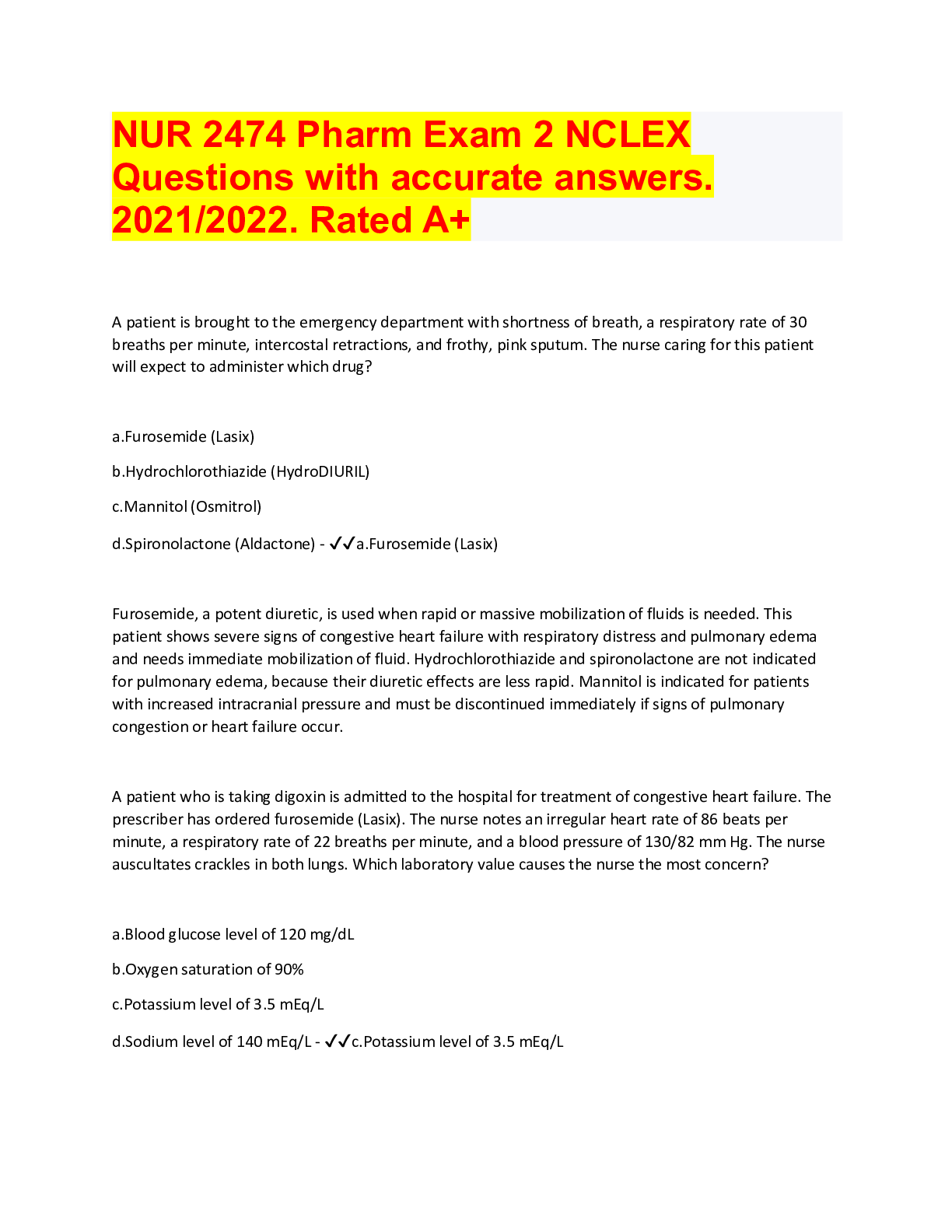
Buy this document to get the full access instantly
Instant Download Access after purchase
Buy NowInstant download
We Accept:

Also available in bundle (1)

NUR 2474 BUNDLE. Questions with accurate answers, 2022
comprises of four different versions. rated A+
By bundleHub Solution guider 2 years ago
$20
4
Reviews( 0 )
$13.00
Can't find what you want? Try our AI powered Search
Document information
Connected school, study & course
About the document
Uploaded On
Aug 16, 2022
Number of pages
44
Written in
Seller

Reviews Received
Additional information
This document has been written for:
Uploaded
Aug 16, 2022
Downloads
0
Views
125














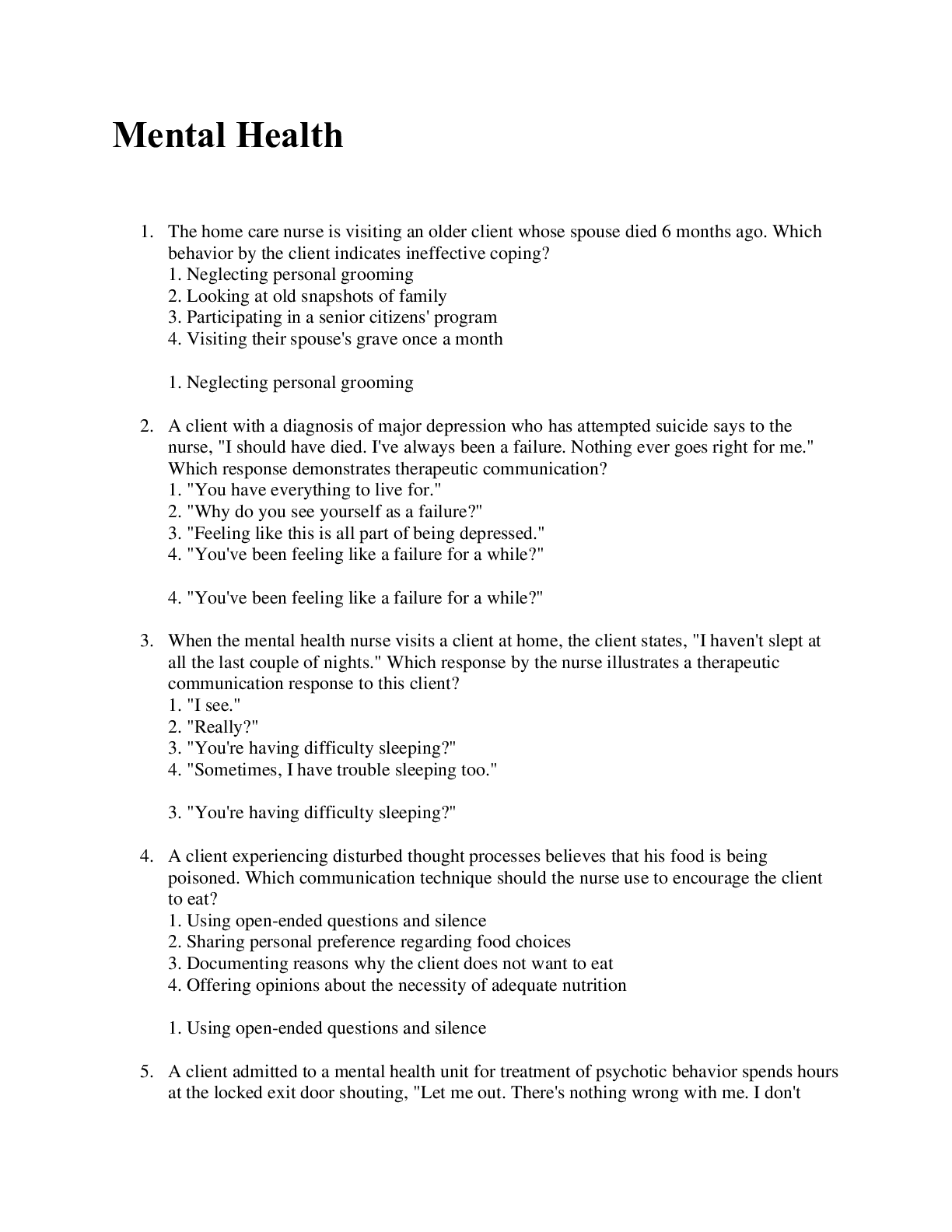
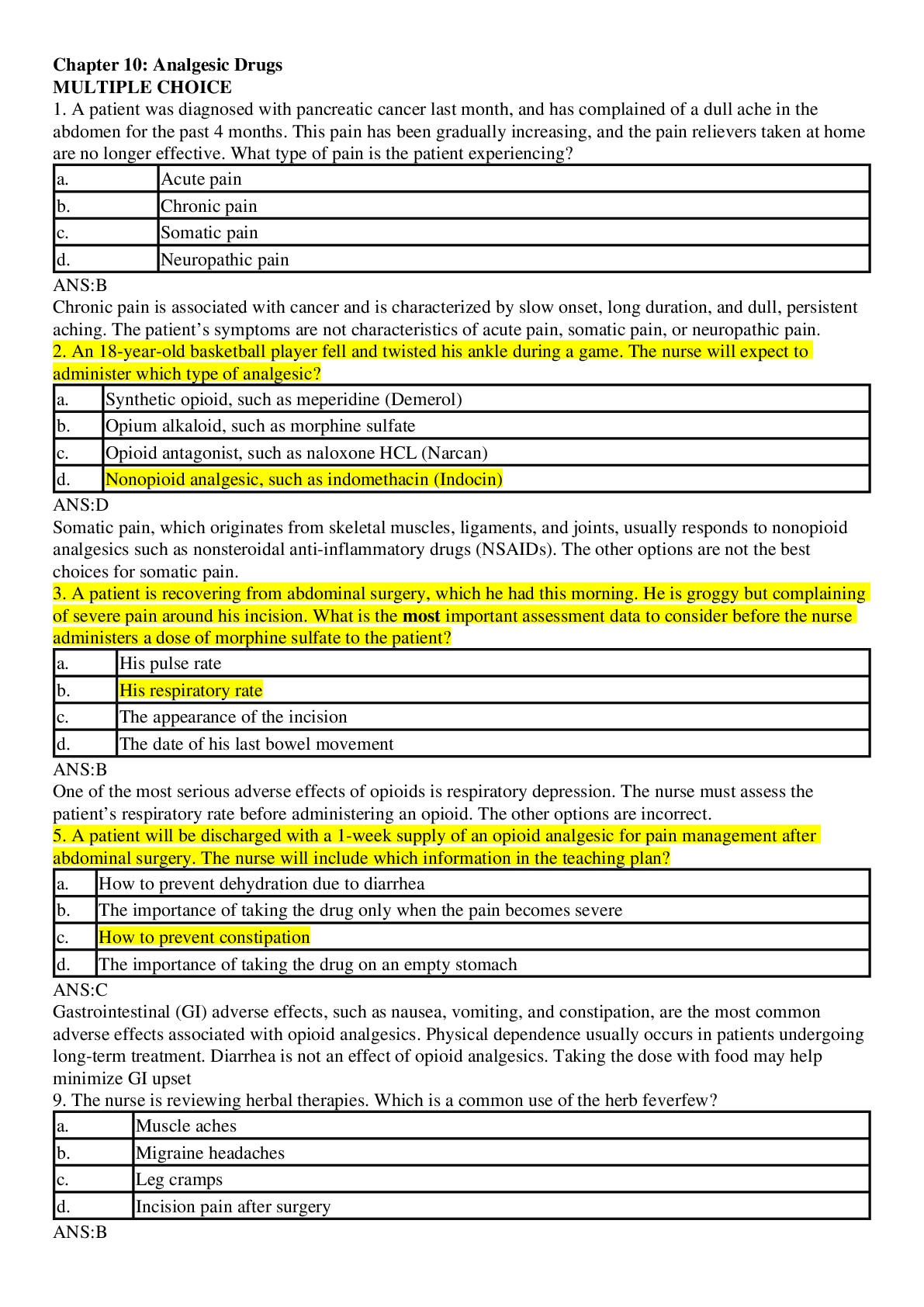
.png)
